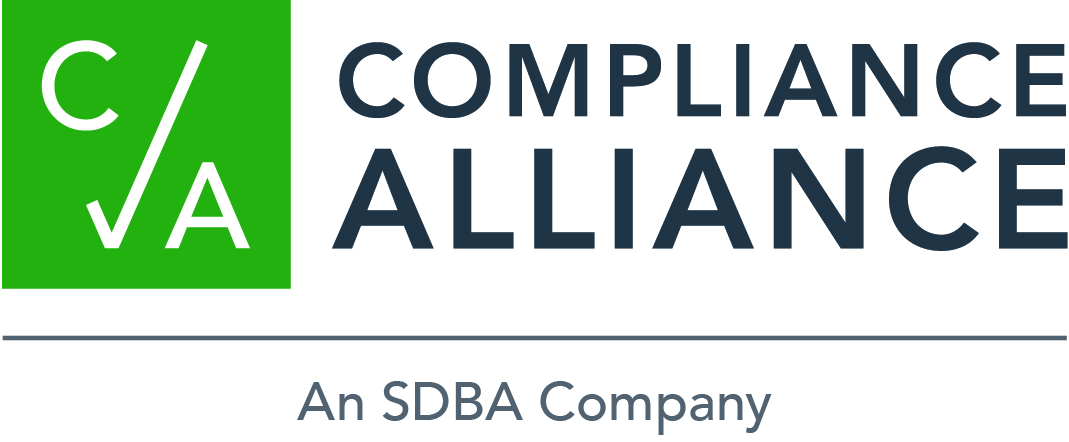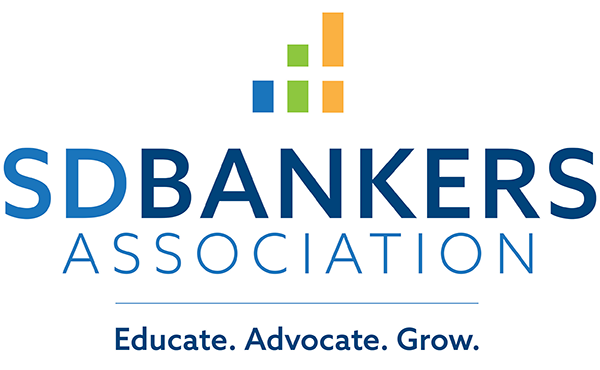|

SDBA Membership Elects New Officers
 SDBA membership elected new officers for 2018-2019 at the SDBA's annual business meeting held June 12 during the 2018 Annual Convention in Fargo. (Pictured left to right are Shawn Rost, Karl Adam and Dave Rozenboom; not pictured is Steve Bumann.) SDBA membership elected new officers for 2018-2019 at the SDBA's annual business meeting held June 12 during the 2018 Annual Convention in Fargo. (Pictured left to right are Shawn Rost, Karl Adam and Dave Rozenboom; not pictured is Steve Bumann.)
The new officers are Chairman Karl Adam, market president, First Dakota National Bank, Pierre; Chairman-Elect Shawn Rost, South Dakota market president, First Interstate Bank, Rapid City; Vice Chairman Steve Bumann, CFO, BankWest, Pierre; and Immediate Past Chairman Dave Rozenboom, president, First PREMIER Bank, Sioux Falls.
The new officers started their year-long terms immediately following the meeting. The official election took place at the SDBA's Annual Convention held jointly with the NDBA on June 10-12 in Fargo. The term for the new officers is effective now through next year’s annual convention in Sioux Falls.
Otting: OCC Working on Interagency Consensus on CRA Reform Plans
The OCC is hoping to issue a long-awaited advance notice of proposed rulemaking on the Community Reinvestment Act in the coming weeks, Comptroller of the Currency Joseph Otting said yesterday, and it has been waiting in order to build consensus with other banking agencies. “We’re hopeful that this can be a joint agency action,” he said while testifying before the House Financial Services Committee.
As he has mentioned publicly on prior occasions, Otting emphasized that the agency’s primary goals for CRA are to expand and provide clarity regarding bank activities that receive CRA consideration, revisit the current assessment area concept and increase transparency and consistency in how CRA performance is measured.
Another priority for the agency is in addressing anti-money laundering and Bank Secrecy Act rules and supervision, Otting said. He said the federal banking regulators met last month and presented recommendations to the Treasury Department and its Financial Crimes Enforcement Network. “We do not have a risk-based examination program; it’s one-size-fits-all,” he said. “We need to bring balance.” He also emphasized the need to raise the $10,000 threshold for Currency Transaction Reports, which he said traps law-abiding business owners and bank customers with accusations of structuring. “We produce a lot of paper and I’m not sure we get to the point where we’re catching the right people.”
Otting also discussed his priorities on small-dollar lending, regulatory capital, Volcker Rule reforms and OCC effectiveness. Since he joined the agency last fall, he said the agency has cut decision and document review time from 22 days to eight and trimmed the agency’s expected costs in fiscal year 2018 by 5 percent. Read Otting's testimony.
Reps. Pearce, Luetkemeyer Introduce ABA-Backed BSA Reform Bill
Reps. Steve Pearce (R-N.M.) and Blaine Luetkemeyer (R-Mo.) on Tuesday introduced an ABA-supported bill that would update several elements of the Bank Secrecy Act and other anti-money laundering laws and regulations. H.R. 6068 would raise the threshold for when Currency Transaction Reports must be filed from $10,000, where it was set by Congress nearly half a century ago, to $30,000, as well as increase the monetary threshold for Suspicious Activity Reports.
The bill would provide an 18-month enforcement safe harbor for financial institutions making good-faith efforts to comply with the recently effective customer due diligence rule. It would also facilitate SAR sharing with foreign bank affiliates, give the Treasury Department a more prominent role in coordinating AML policy and require studies of streamlining CTR and SAR reporting requirements and of the effectiveness of new beneficial ownership requirements.
“We believe that now is the time to update the law and help develop a system suited for both 21st-century banks and a more sophisticated criminal element,” ABA said in a letter yesterday supporting the bill. “And it is important to take steps so that BSA/AML compliance doesn’t drive transactions and financial activity underground where it is out of the view of law enforcement.” Read ABA's letter.
Fed Announces Second Interest Rate Hike of 2018; Signals Two More this Year
As expected by analysts, the Federal Open Market Committee announced another quarter-point rate hike at the conclusion of its meeting yesterday, marking the second rate hike increase of 2018. Citing strong economic growth--including a strengthening labor market, falling unemployment and increased household spending and business fixed investment--as well as overall inflation approaching the 2 percent target, the committee voted unanimously to raise the federal funds rate 25 basis points to a range of 1.75 to 2 percent. Members’ longer-term inflation expectations were little changed, according to the statement released by the committee.
Significantly, the FOMC removed from its statement language stating the committee’s expectation that monetary policy would “for some time” remain accommodative, signaling that members expect interest rates to move to a more neutral level in the near future. The committee signaled two more rate hikes this year and three for 2019. Read the FOMC statement.
ABA Raises Concerns about Proposed Changes to FHLB Affordable Housing Program
In a comment letter to the Federal Housing Finance Agency on Friday, ABA called on FHFA to reconsider its approach to modifying the Federal Home Loan Bank Affordable Housing Program. ABA noted that the FHFA’s recent proposed rule would impose a complex, highly-prescriptive, outcomes-based framework for awarding AHP funds that is less flexible, more complex from a compliance standpoint and less transparent.
The proposal would require a majority percentage of AHP funds to be awarded to certain types of projects established by FHFA, which ABA noted would serve to centralize decision making in Washington, D.C., rather than in the local communities where needs exist. It would also establish that at least 55 percent of a FHLB’s required annual AHP contribution is awarded to projects or households that meet at least two of the three regulatory priorities established in the rule. FHLBs that do not meet these requirements will face harsh penalties under the proposal that do not exist currently.
Since its creation in 1990, the AHP has become an important tool for banks to help address affordable housing needs in their local communities. “Revisions to the AHP should focus on making the program more efficient and responsive to locally-identified needs, not on imposing strict new national standards and penalties,” ABA said. View the comment letter. For more information, contact ABA's Joe Pigg.
ABA Foundation Releases Free Guide to Partnerships that Protect Senior Customers
To mark World Elder Abuse Awareness Day on Friday, the ABA Foundation is this week releasing a free new guide to help bankers combat financial exploitation of seniors. Seniors currently lose an estimated $2.9 billion per year to financial abuse, and with a growing number of baby boomers retiring, scams targeting the elderly are growing.
The new guide provides an overview of the state of financial exploitation; addresses top scams currently in play; examines what banks can do, including how to report suspected fraud; and outlines the distinct roles of law enforcement agencies and adult protective services and how to partner with them. It also includes several sample resources, including introduction letters to law enforcement, APS, senior-focused nonprofits and senior living facilities.
The guide is part of a broader set of ABA Foundation resources to help bankers protect their senior customers. Through aba.com/seniors, bankers can register for FinEdLink, a free platform that connects participating banks with senior-focused community groups and agencies that would like a banker-led presentation on senior financial safety.
Seats Available at 2018 National School for Experienced Ag Bankers
A limited number of seats still remain for the 2018 National School for Experienced Ag Bankers, which will be held June 25-29 in Spearfish. The school, which is hosted by the SDBA, targets ag bankers with a strong knowledge of financial analysis in ag banking who desire further training in analyzing and troubleshooting more complex and problem credits.
Instructors at this school will provide course material primarily by case study and supported by lectures and intensive analysis. Students will be taken through a “live” case study and other rapid fire case studies. Instructors will provide valuable information and additional analytical tools that will inspire action as attendees learn to apply the techniques in more complex loans.
Students will continue their education by learning about commodity grain marketing fundamentals through participation in a simulation game. Lender liability issues, grassroots efforts and the bank regulator’s role will also help “round out” the education. Ag bankers will achieve higher skills that will help with early identification of problem loans and determining solution options.
Learn more and register today.
ABA to Host Webinar on S. 2155's Capital Simplification Provisions
An upcoming webinar hosted by ABA on Thursday, June 21 at 1 p.m. CDT, will delve into how S. 2155--the new regulatory reform law--will provide relief for community banks from the complex Basel III standards. The law directs the banking agencies to develop an approach that would identify highly-capitalized community banks and exclude them from the Basel III capital standards. Under such an approach, highly-capitalized banks with total assets of less than $10 billion would be identified by using a simple leverage ratio that is no lower than 8 percent and no higher than 10 percent.
ABA issue experts will discuss the issues regulators will need to address as they work to implement the provision, as well as the future of community bank regulatory capital standards. The presentation will include a Q&A session. Learn more and register for the webinar
 Question of the Week Question of the Week
Question: We used to say if the funds were improving the commercial part of the building with no benefit to the dwelling it was not reportable. In 2018 is a loan for improving a veterinary clinic that is under the same roof as an individual’s home reportable?
Answer: For mixed-use buildings, the closed-end mortgage loan would be reportable if the proceeds go toward either:
1. improving the whole property, or
2. primarily improving the residential portion of the property.
For example, if the loan were to replace the A/C for the whole building, or replace the floors on the residential side, then it would be reportable:
MIXED-USE PROPERTY.
A closed-end mortgage loan or an open-end line of credit to improve a multifamily dwelling used for residential and commercial purposes (for example, a building containing apartment units and retail space), or the real property on which such a dwelling is located, is a home improvement loan if the loan's proceeds are used either to improve the entire property (for example, to replace the heating system), or if the proceeds are used primarily to improve the residential portion of the property. An institution may use any reasonable standard to determine the primary use of the loan proceeds. An institution may select the standard to apply on a case-by-case basis. See comment 3(c)(10)-3.ii for guidance on loans to improve primarily the commercial portion of a dwelling other than a multifamily dwelling.
https://www.consumerfinance.gov/eregulations/1003-Subpart-Interp/2017-18284_20180101#1003-2-i-Interp-4
Compliance rules and regulations change quickly. For timely compliance updates, subscribe to Compliance Alliance’s email newsletters.
Compliance Alliance offers a comprehensive suite of compliance management solutions. To learn how to put them to work for your bank, call 888.353.3933 or email.

SDBA eNews Archive
View past issues of the SDBA enews
Advertising Opportunity
Learn more about sponsoring the SDBA eNews.
Questions/Comments
Contact Alisa DeMers, SDBA, at 800.726.7322 or via email.
|


 SDBA membership elected new officers for 2018-2019 at the SDBA's annual business meeting held June 12 during the 2018 Annual Convention in Fargo. (Pictured left to right are Shawn Rost, Karl Adam and Dave Rozenboom; not pictured is Steve Bumann.)
SDBA membership elected new officers for 2018-2019 at the SDBA's annual business meeting held June 12 during the 2018 Annual Convention in Fargo. (Pictured left to right are Shawn Rost, Karl Adam and Dave Rozenboom; not pictured is Steve Bumann.)
